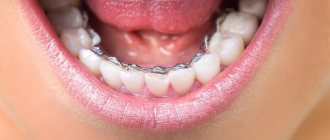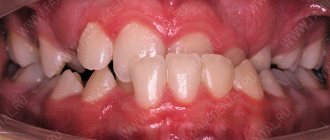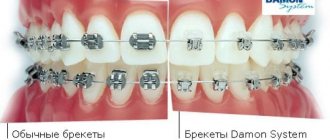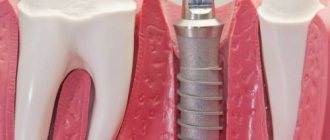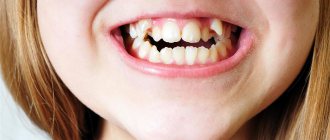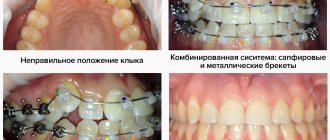The effectiveness of orthodontic correction of defects of the dental system directly depends on the age of the patient. It is considered optimal to carry out treatment in children at the stage of mixed and emerging permanent dentition. In this regard, correction of dentition defects is one of the most important areas of pediatric dentistry.
If the time for wearing plates is missed, braces can be used in children. For some reason, it is believed that this orthodontic structure cannot be used until adolescence. At the same time, it is in children that the bite problem can be solved most simply and quickly, without waiting for crooked teeth to become “overgrown” with complexes, a feeling of insecurity about one’s own attractiveness and problems in interpersonal communication.
The principle of operation of the braces system
Orthodontic construction, widely used to give teeth the correct position in the jaw, consists of a number of individual elements. First of all, these are clasps that are attached to the enamel surface. They are united into a single system by a force arc - a thick wire that creates the necessary pressure on the teeth.
Braces (clasps), individual elements with special grooves or clips for wires, are necessary to fix the structure on the teeth. Most often they are made of metal, but there may be other options. The clasps are held on the surface of the tooth using a special dental adhesive.
Dental wire is no different in appearance from ordinary metal wire and is gray in color. In expensive orthodontic systems, which are almost invisible on the teeth, white wire may be used. A feature of the arc is “shape memory”. Initially, it has a configuration that corresponds to an ideal bite. When the wire is deformed by the doctor during the installation of the system, it tends to return to its original position, pulls the clasps with it and thus helps correct the position of the teeth.
Which braces should a teenager or child choose?
Correcting the bite in children is a fairly common type of dental treatment. Parents often have to think about how to choose braces for a child or teenager. The best option is to listen to the advice of a pediatric orthodontist.
When discussing different options, it is worth taking into account the child's personality. If he is shy or has complexes, then it is better to install one of the “invisible” types of systems. But children, as a rule, are less concerned about aesthetics, so they are most often fitted with classic metal braces.
Features of the children's braces system
Nowadays, orthodontic treatment can be performed on patients of all ages. Dentists actively encourage adults to correct their bite. At the same time, children and adolescents with crooked teeth, for whom the optimal period for correcting dentoalveolar anomalies has arrived, fade into the background. From 12 to 18 years of age, active formation of the jaws occurs, the tissues are flexible, and the teeth respond well to the pressure exerted on them. You can achieve the desired result with the least effort. However, for some reason many adults believe that “the child will outgrow it” and “the teeth will straighten out on their own.”
Up to 12 years of age, during the period of mixed dentition, orthodontic correction can also be carried out. However, the bracket system cannot be used for this purpose, since during this period the pressure of the structure is excessive. It is more advisable to use plates and other orthodontic devices that have a softer and more gentle effect on the dental system.
The age for starting orthodontic correction using a brace system at 12 years is indicated very arbitrarily. The development of children is uneven, so the orthodontist must take into account the individual characteristics of the young patient when determining the indications for starting treatment. The specialist’s decision is based on data from a dental examination and x-ray examination. In fact, the child undergoes the entire range of diagnostic tests that are necessary for an adult patient in the same situation. However, the objectives of the examination differ, just like the algorithms for determining indications and contraindications for treatment.
Children's braces, in addition to a special approach to installation, differ from adults in a shorter wearing period. However, the cost of orthodontic correction in children and adolescents may exceed that in adults.
We check whether the child needs a visit to the orthodontist
There are a number of signs that indicate the need for orthodontic treatment in children:
- crowding and creeping of some teeth onto others;
- the presence of diastemas - large gaps between the teeth;
- Losing some baby teeth too early.
In addition, there are some hereditary factors that can influence the appearance of teeth in children. It has been proven that children of those people who have ever suffered from malocclusion and needed treatment will also be forced to resort to the services of an orthodontist to obtain an aesthetic and healthy smile.
Types of children's braces
A fairly large number of modifications of brace systems have been developed and are used, which differ from each other in the location of the structure in the oral cavity and the material from which the clasps are made. Most types of systems can be successfully used in patients of all ages, starting from 12 years of age.
Ways to arrange the structure
Most often in the practice of an orthodontist, vestibular corrective structures are used. Vestibular clasps are attached to the outer surface of the dental crown. Such a device is much easier to install, adjust, and clean from plaque and food debris. Obvious shortcomings include the unaesthetic appearance of the system, which is visible when smiling and during a conversation.
Lingual braces, which are installed on the lingual surface of the teeth, are completely invisible to others and are just as effective as vestibular braces. However, they are made individually from gold and other expensive metals, which determines the high price of the structure. A system for one jaw can cost a patient 120 thousand rubles or more. The system also significantly reduces the oral cavity and limits the movement of the tongue, which affects diction.
For children and adolescents, the aesthetic side of the issue of orthodontic correction is very acute. Any comments or non-verbal signs of disapproval from peers regarding “braces on the teeth” may lead to refusal to continue treatment.
What are dental braces and how do they work?
A bracket system is a combination of several elements: locks attached to the surface of the tooth and an arch connecting them. Depending on the design features, ligatures can additionally be used - wire or elastic rubber rings to secure the fasteners. The operating principle of the system is based on the elasticity of the metal arch, which tends to return to its original shape, thereby gradually straightening the dentition.
Braces systems are divided into several types:
- by type of fixation on the jaw - vestibular (external) and lingual (internal);
- according to the method of fastening the locks - ligature and self-ligating;
- according to the material of manufacture - metal, sapphire, ceramic, plastic, combined.
Braces can be installed on both jaws or on one jaw. The second option is usually practiced in cases where only the lower or upper row of teeth is deformed. However, the orthodontist may recommend a phased installation of two systems; if the defects on one of the jaws are less pronounced, less time will be required for correction. In addition, a pause between procedures makes it easier for the child to get used to the structures.
At what age do children get braces?
The optimal time to install braces for children is considered to be adolescence - from 12 to 14 years. This opinion is shared by most orthodontists, since the tooth enamel in adolescents is already quite strong, but at the same time, the dentition can be easily and effectively corrected.
Sometimes it is practiced to install permanent structures earlier, after the child reaches 7-9 years of age. It is recommended to install braces at this age for two main indications:
- diastemas (large distances) between the molar central and lateral incisors, which look unaesthetic and prevent the correct eruption of the canines (there is too little space for them);
- displacement of the front teeth back, forward or their rotation around their own axis.
A necessary condition for installing a bracket system at an early age is the presence of all molars and first molars with sufficiently strong enamel. At the same time, they are placed partially, precisely on these 6 teeth, and the system itself is called “2x4”. This approach allows you to correct the dentition quickly and effectively, without unnecessary material costs in the future.
Note! It is best to put braces on a child 12 years of age or older, when it is possible to install a full-fledged structure, but even then, an important condition for successful treatment is contacting an experienced orthodontist.
Early installation of braces without thorough preliminary research and subsequent monitoring can cause root resorption, enamel destruction, and tooth loss. At the YuliSTOM clinic, specialists have the required level of qualifications and select an individual correction program taking into account all the characteristics of the small patient.
Installing braces for a child
Ligature and self-ligating systems
Ligatures are additional elements of the bracket system that hold the arch in the groove of the lock. At the initial stage of treatment, pieces of thin wire are used as ligatures. Then they are replaced with elastic bands. The main purpose of the ligatures is to ensure the movement of the clasps following the changing shape of the arch. The wire fixes the braces very tightly, which often leads to uneven load on the teeth. In this regard, aching pain may appear that an adult, let alone a child, can hardly endure. Rubber bands are stained with pigments from food and drinks, which requires their regular replacement.
In self-ligating systems, the clasps have a special clip that secures the arch. The connection using a clip is not as rigid as using a wire ligature. As the teeth shift, the clasps can move within a small range relative to the power arc, which allows the load on the dental system to be distributed more evenly.
It is impossible to say for sure which system is better. Each of them does an excellent job of eliminating dental defects. The duration of treatment does not depend on the type of structure used. The patient will have to visit the dentist to correct the system with approximately the same frequency. Ligature-free systems are made from a variety of materials, which allows you to “play” with shape and color. Ligature rubber bands can be of a variety of colors, which, if desired, allows you to turn an orthodontic structure into a stylish accessory.
Types of braces depending on material
Metal locks are the most reliable. They are small in size, securely attached to tooth enamel, and are the most durable of all. They are also the most affordable. Their widespread distribution is hindered by the unattractive appearance of the metal structure on the teeth. As a rule, in order to save money, metal braces are often used with ceramic and even sapphire ones, placing colorless elements on the front teeth, and reliable iron ones on large and small molars.
Metal locks are made of titanium, the power arc is made of an alloy of titanium and nickel. It is this combination that gives the product sufficient strength and the ability to withstand significant loads for a long time.
Ceramic braces come in many different shades. The color of the material can be matched to the natural color of the enamel, which will make the locks almost invisible. When producing braces, the greater fragility of dental ceramics compared to metal is taken into account, which is why ceramic clasps are larger than metal ones.
Sapphire braces are made from artificially grown gemstones. They are completely transparent and have a characteristic shine, reminiscent of the shine of jewelry. They are more durable than ceramic and do not change color under the influence of external factors. If you use a white rather than a gray archwire for sapphire clasps, the design becomes almost invisible in the mouth. The only drawback of the sapphire bracket system is its high cost, which significantly “bites” even if some of the clasps that are not visible during a conversation are replaced with metal ones.
Psychological preparation of the child
Not every parent can afford orthodontic treatment using sapphire or lingual braces. Yes, this is not always necessary. In addition to the fact that vestibular braces look unsightly, it is necessary to remember that the teeth hurt for the first time after installation, the structure is difficult to clean, and it is even difficult to eat with it. The right attitude helps a teenager cope with discomfort, find ways to turn design flaws into a reason for self-expression (choose colors and color combinations of ligatures, for example).
It is important to respect the child’s opinion and take into account his interests. You should not hush up possible problems associated with everyday wearing of the device, so that later the difficulties do not become an unpleasant surprise for the young patient and cause a decrease in motivation to continue treatment. Carrying out bite correction should be the decision of the child, and not the adults around him, since this is a complex and quite uncomfortable matter.
At the age of 12, not many children think about the need to correct their bite. It is necessary to develop in them an understanding of the importance of the beauty of a smile in interpersonal communication, an understanding of the relationship between the state of the oral cavity and the general state of human health. Well, the most important thing. Even before installing the system, it is necessary to take care of acquiring purely practical skills in caring for the structure. It will be much easier for a young patient to brush his teeth and braces with them if he has already formed the habit of using zuna floss, an irrigator, and mouth rinse.
Parents can teach their child by example by mastering the correct method of brushing teeth and using it regularly. All family members will benefit from this. Also, the time a child wears braces can be used to change the diet of all members. An orthodontic patient cannot eat solid food, so any chips and crackers are prohibited. Sticky and viscous products will take a long time to clean out from the spaces between the enamel and the arc. Changing the diet will allow you to avoid situations where the child feels deprived and switch to eating more healthy foods.
Main selection criteria
When choosing braces for a teenager, parents need to consider several important points.
Criterias of choice:
- If the speed of treatment is important, then you need to install metal braces to achieve quick results.
- Plastic braces require careful oral care. If the child responsibly follows all the rules of hygiene, then such a system can be installed to correct the bite.
- If a child is embarrassed to wear orthodontic structures, or there is a serious psychological barrier, then it is worth considering the option of installing ceramic braces that are invisible to others.
- If a child is capricious and does not want to give up a number of forbidden foods that can cause damage to the orthodontic system, then it is better to install metal braces, which are characterized by the highest strength.
- Sapphire braces are the best option for installation, but parents will have to spend a lot of money on such a design.
The choice of braces for installation in a teenager should be agreed with the attending doctor. The specialist will help you make the right decision, taking into account the complexity of the clinical case and the patient’s wishes.
How long to wear braces?
Minimum period of wearing braces for teenagers
– 1-1.5 years. In general, the timing of wearing orthodontic systems depends on the complexity of the pathology.
Braces care
In order to clean your teeth and structures from dirt every day, you will have to purchase several special devices at once:
- An orthodontic toothbrush, thanks to its special shape and softer bristles, cleans teeth more thoroughly without the risk of the clasps coming off;
- small brushes, the heads of which are placed between the arch and the surface of the teeth;
- dental floss;
- a special toothpaste and rinse that inhibits the growth of bacteria in the oral cavity after brushing;
- irrigator, a special device that allows you to clean plaque from places where a brush and brushes cannot reach.
The child should be prepared to spend much more time than usual on hygienic cleaning. Especially if before that he did not use a toothbrush every day. The braces system increases the likelihood of developing caries, so you will have to take extra care of your teeth throughout the entire treatment period.
How long does a child need to wear braces?
The duration of treatment depends on the age of the child and the intensity of the problem. Minor distortions can be corrected in a few months, and serious violations can be corrected in 1–2 years. Rarely do children have to wear braces for longer than 1 year.
The brand of braces also affects the duration of treatment. For example, the manufacturer Damon uses technology to reduce the treatment period by several months, even for adults. The doctor will determine the approximate period during consultation after selecting suitable designs.
Cost of braces
When discussing the cost of orthodontic treatment, many parents focus only on the price of the braces system. This is one of the most significant expense items, but far from the only one. The average cost of a metal structure per jaw is about 60 thousand rubles. The sapphire system will cost twice as much. It is also necessary to take into account the cost of examination, sanitation of the oral cavity, periodic scheduled examinations to adjust the system, professional oral hygiene procedures once every 3 months. Do not forget about force majeure, when you will have to contact an orthodontist unscheduled. This is a broken arc, unsticking of a lock and other damage that must be removed in a timely manner.



